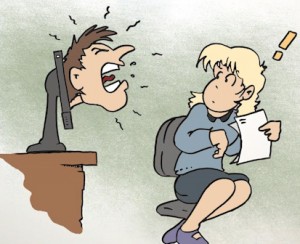by Nancy Friedman
If your job includes handling unhappy, irate customers, you’ve got your work cut out for you. Team members who deal with these delicate situations are often exposed to emotional outbursts from customers who are extremely upset.
Handling these types of interactions requires patience and the proper techniques. Here are some quick strategies for turning irate customers into satisfied clients.
Start Off on the Right Foot
Realize that angry customers are not normally upset with you, but with the situation. Don’t take their hostility personally. You’re merely the rod that redirects the violent lightning strike. You can start to diffuse the anger at the start of the call by smiling. You really can “hear” a smile over the phone. And, it’s more difficult to be rude to a service provider who’s warm, genuine and sounds concerned.
The ASAP Technique
There are four basic steps to handling an irate customer. We call it the ASAP technique.
A – Acknowledge & Apologize. Soothe the customers’ feelings. Immediately. Don’t wait to find out who’s wrong. Or whose fault it is. Apologize and acknowledge immediately. Always be sincere. In today’s impersonal society, it’s incredibly rare to hear the words, “I apologize for what happened. Let’s get the ball rolling to fix it.” A simple statement like that goes a long way. In fact, you’ll probably spend about 80 percent of your time massaging the customer’s feelings and 20 percent actually solving the problem.
S – Sympathize and empathize with the customer. Use phrases that offer to help soothe ruffled feathers. “That’s got to be very frustrating.” or “I can certainly understand why you’re upset.” Then get to work on solving the problem. Explain what’s going to happen. Run them through the process.
A – Accept responsibility for guiding this towards a resolution. This is probably the toughest part. Chances are excellent that you had nothing to do with the problem. However, if you took the call and are handling this customer, it’s now your job to take the responsibility and help initiate a solution.
P – Prepare to help. Immediately. Begin by re-introducing yourself. Customers won’t usually remember your name. If you have a title, give it to them. Status helps too. “Again I’m Emma, the Assistant Manager.” Assure them that you’ll be able to help. And use their name when possible. This helps a bit to diffuse their frustration. A willing attitude is essential, because if the customer senses insincerity or indifference, it will cause them to stay angry. It’s exasperating to file a complaint with someone who obviously doesn’t care.
Excuses = “I’m not going to help you now!”
It’s never a good idea to make an excuse to a customer. It may very likely escalate the situation. No one wants to hear “The computer is down” or “I’m the only one here.” That’s your problem, not theirs. When you give an excuse, the customer automatically translates that into you telling them “I’m not going to help you now.”
In person or on the phone – the ASAP technique will help you diffuse irate customers and lead them down the path to service recovery.
########
Interesting in learning more customer service skills? Download our free eBook here.
For info on our popular half-day, on-site training workshops, please contact Cheryl Theide.
We encourage you to forward this article to colleagues or include it in your internal publication with the following credit line: “Reprinted with the permission of Telephone Doctor Customer Service Training www.telephonedoctor.com”
